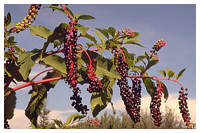
Off to the Races With Pokeweed Wine
By GERALD TORRENCE
1801 Brock Street, Judsonia, AR 72081
|
I |
n April 2000 a rural tradition slipped quietly into the past with few noticing and still fewer caring. Allen Canning Company of Siloam Springs canned its last batch of poke sallet greens. From now on you will have to gather your own if the craving for poke greens overtakes you as the brown beans simmer in the pot. Pokeberry or pokeweed is a ubiquitous weed from Maine to Miami to Mexico, so it is not surprising our White County forefathers found a use for it, in fact several uses. It is a stout herbaceous perennial that, in good soil can form a thigh-size taproot.
The taproot is poisonous and there are reports of careless gardeners mistaking pokeroot for horseradish roots with dire consequences. American Indians used poke roots as a laxative and an emetic. From the crown of the plant emerge leafy, asparagus-like shoots that are edible during the first days of spring. If these smooth purple-tinged shoots are allowed to grow they can reach six to 10 feet tall. By midsummer plants begin to produce six-inch long racemes of greenish white flowers. The flowers give rise to juicy pea-size berries that transition from green to pink to dark purple. The berries are a favorite food for berry-eating songbirds.
Poke gets it name from an Indian word “pokan” which means any plant used to produce a red or yellow dye.
My brother and a friend when they were teenagers decided to make pokeberry wine. They put all the stuff they that they thought went into wine. Every body knows that good wine is at its best when it is aged, so they let it age all night. The next day, they each got a glass full. My brother said that was the worst-tasting stuff he had ever put in his mouth. For two days they changed the path to the outhouse into a racetrack. My brother said he had enough pokeberry wine to last him a lifetime.
John Williams, the canning supervisor at Allen Canning, said “The decision to stop processing poke was primarily because of the difficulty of finding people interested in picking poke and bringing it to our buying location, and it was more of a bother then it was worth.” vvv

(The author is a member of the White County Historical Society. He is pictured on Torrence Street in Pangburn.)